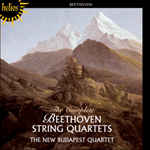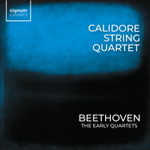
Welcome to Hyperion Records, a British classical label devoted to presenting high-quality recordings of music of all styles and from all periods from the twelfth century to the twenty-first.
Hyperion offers both CDs, and downloads in a number of formats. The site is also available in several languages.
Please use the dropdown buttons to set your preferred options, or use the checkbox to accept the defaults.

| Calidore String Quartet» More |
The Minuet (not a scherzo) comes second. It is still in A major and the elegance is continued, though with an abrupt excursion into a blunt C sharp minor in the second part, from which the gentle music reacts as if nothing has happened. The Trio consists of a beautiful tune enlivened by off-beat accents.
Any suspicion of casualness provoked by the first movement was already assuaged by the Minuet, and is now laid fully to rest in one of the finest of his early variation movements. Beethoven shows what can be done with a simple falling and rising fragment of diatonic scale. The D major theme is simplicity itself, but of striking beauty, and the first three variations animate it with growingly active figuration, the third strongly anticipated Schubert. The fourth variation is of exquisite calm and depth — the theme is intact but harmonised with surpassing sensitivity. Variation 5 returns to vigorous, even rough, activity and leads directly to a long and felicitous coda in which the scales are given in diminution (i.e. in shorter notes) producing an altogether new development, beginning in the magically remote key of B flat, from which the return to the tonic is delightful.
In the Finale we find much contrapuntal invention and a highly original quartet texture, with what by now we must expect in Beethoven, a magnificent sense of movement. The quicksilver motion is offset by a splendidly broad second theme that is carried with consummate ease by the general current.
from notes by Robert Simpson © 1990
Le Menuet (et non un scherzo) vient en second. Il est aussi en la majeur et l'élégance se poursuit, malgré une brusque excursion aboutissant avec brutalité vers un do dièse mineur, à laquelle la musique aux sonorités douces réagit comme si rien ne s'était passé. Le trio consiste en une belle mélodie animée d'accents à contretemps.
Toute suspicion d'insouciance qui aurait pu être provoquée par le premier mouvement a déjà été apaisée par le menuet, et se trouve maintenant totalement dissipée par un de ses plus beaux premiers mouvements de variation. Beethoven montre ce qui peut être effectué grâce à un simple fragment ascendant et descendant de gamme diatonique. Le thème en ré majeur, la simplicité même, est cependant d'une beauté frappante et les trois premières variations l'animent avec une figuration d'une activité croissante, la troisième anticipe fortement Schubert. La quatrième variation est dotée d'une profondeur et d'un calme exquis — le thème reste intact mais s'harmonise d'une sensibilité sans égale. La cinquième variation qui retourne vers une activité vigoureuse, voire brutale, aboutit directement à une longue coda arrivant à propos, dans laquelle les gammes sont données en diminution (c'est à dire en notes plus brèves) afin de produire un développement entièrement nouveau, commençant dans une tonalité magique et lointaine en si bémol dont le retour à la tonique est un délice.
Le finale présente des contrepoints inventifs ainsi qu'une texture de quatuor hautement originale dotée d'un magnifique sens au mouvement, ce à quoi nous devrions maintenant nous attendre chez Beethoven. Ce mouvement de vif-argent est contrebalancé par l'ampleur splendide du second thème qui est porté avec une aisance consommée par le courant d'ensemble.
extrait des notes rédigées par Robert Simpson © 1990
Français: Marianne Ferne
Das Menuett (kein Scherzo) kommt als zweiter Satz. Es ist noch in A-Dur, und die Eleganz bleibt erhalten, wenn auch mit einem abrupten Exkurs in ein brüskes cis-Moll im zweiten Teil, auf den die sanfte Musik reagiert, als ob nichts geschehen sei. Das Trio besteht aus einer herrlichen Melodie, die von synkopierten Akzenten belebt wird.
Jeder vom ersten Satz hervorgerufene Verdacht der Lässigkeit war bereits vom Menuett beschwichtigt worden und wird nun in einem der feinsten seiner frühen Variationssätze völlig beruhigt. Beethoven zeigt, was sich mit einem einfachen fallenden und steigenden Fragment einer diatonischen Tonleiter machen lässt. Das D-Dur Thema ist die Einfachheit selber, aber von eindrucksvoller Schönheit, und die ersten drei Variationen beleben es mit einer zunehmend lebhaften Figurierung, die dritte greift deutlich auf Schubert voraus. Die vierte Variation ist von exquisiter Ruhe und Tiefe — das Thema bleibt unberührt, wurde aber mit unvergleichbarer Empfindlichkeit harmonisiert.
Variation 5 kehrt zu der kräftigen, sogar robusten Lebhaftigkeit zurück und führt direkt zu einem langen und glücklichen Schlussteil, in dem die Tonleitern mit Verkürzung der Notenwerte gegeben werden, wodurch eine ganz neue Durchführung geschaffen wird, die mit der magischen unnahbaren Tonart von h-Moll beginnt, aus der die Rückkehr zur Tonika entzückend ist.
Im Finale finden wir viel kontrapunktische Phantasie und eine hochoriginelle Quartettstruktur mit einem grossartigen Gefühl aer Bewegung, wie wir es jetzt bereits bei Beethoven erwarten müssen. Die Quecksilberbewegung wird von einem herrlich breit angelegten zweiten Thema ausgeglichen, das mit vollendeter Leichtigkeit vom allgemeinen Strom entlanggetragen wird.
aus dem Begleittext von Robert Simpson © 1990
Deutsch: Hans Jürgen Wienkamp
 Beethoven: String Quartets Beethoven: String Quartets‘Fine performances, always intelligent, with many considerable insights … perfect intonation and excellent ensemble and tonal blend, with first-c ... ‘Very fine … I enjoyed these performances because they deliver Beethoven as I want him, free of the biographical sensationalism. Highly recommend ...» More |
 Beethoven: The early quartets Beethoven: The early quartetsThe string quartet was perhaps the most prestigious (and certainly the most lucrative) genre for a composer at the turn of the nineteenth century. Beethoven left nothing to chance with his inaugural Op 18 set, and they were a triumph, here perform ...» More |

